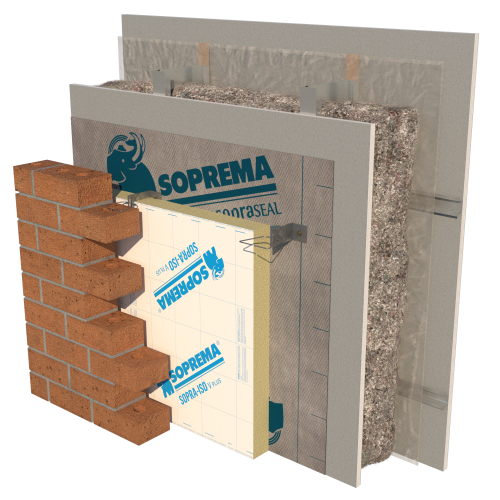
What is a Wall Assembly?
The wall assembly consists of a system of components that fulfill the support, control, and finish function of the building envelope. While the precise placement and configuration of each component may vary between climates and individual buildings, the following components are typically found in the wall assembly (from exterior to interior).
The interior finish is the surface of the wall assembly that the occupants will interact with on the the interior of the building. The interior finish is typically comprised of gypsum board, colloquially known as drywall.
Learn more about our Interior Finishing Solutions >>
The air and/or vapour barrier is an essential component of the wall assembly. If water makes its way through the wall and wets the insulation, significant damage can occur to the insulation, decreasing its heat retention, and potentially growing mold. Air and water vapour mass transfer through the wall assembly is primary controlled by the properties of the air/vapour barrier. In some cases, two separate barriers are installed, one for air control and one for vapour control. The location of the barriers in the wall assembly is dependent on the exterior climate and interior use. Typical residential wall assemblies use polyethylene sheets as the primary air/vapour barrier.
Learn more about our Vapour/Air Barriers >>
A variety of structural support forms are available to transfer loads through the wall assembly. In a typical residential wall, wood studs comprise the primary structural component. However, commercial and industrial buildings wall assemblies may be structurally supported by variety of components such as cold-formed steel studs, reinforced concrete, mass masonry, and structural steel members. The insulation is typically placed in the interstitial space between structural components.
Learn more about our Structural Steel Solutions >>
Insulation is any material used in the wall assembly to retard the transfer of heat through the wall. Commonly used materials include fiberglass batts, polyisocyanurate rigid board, and polyurethane foam.
Learn more about our Interior & Exterior Insulations >>
The flat surface that receives the exterior sheathing membrane around the perimeter of the building. Typically the exterior sheathing is comprised of a manufactured wood product such as plywood or oriented strand board (OSB).
Learn more about our Exterior Sheathing >>
The exterior sheathing is the waterproofing membrane that protects the underlying structure from bulk moisture ingress. Residential homes typically use asphalt impregnated kraft paper, colloquially referred to as building wrap. Modern commercial structures typically rely on more modern waterproofing systems such as self-adhering styrene-butadiene-styrene (SBS) rubberized asphalt sheets.
Learn more about our Exterior Membranes >>
The exterior cladding is the first barrier to prevent bulk moisture penetration into the building interior. Examples of typical materials include stucco, exterior insulation finishing system (EIFs), clay brick, vinyl siding, and cedar siding.

Sources:
- Image © 2008 the International Association of Certified Home Inspectors, Inc. (InterNACHI).
- https://energyeducation.ca/encyclopedia/Wall_assembly
Our sales team is happy to help connect you with the right product. Simply contact us with your wishlist and we’ll see how we can help!


